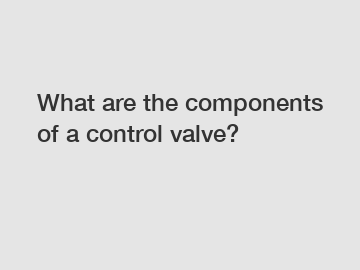What are the components of a control valve?
Control valves play a vital role in regulating fluid flow and ensuring precise control within various industrial processes. These devices are responsible for maintaining the desired operating conditions, making them indispensable in sectors such as manufacturing, oil and gas, energy, and many others. To truly comprehend their significance, it is essential to delve into the complex world of control valves and understand their key components. In this blog, we will explore the fundamental elements that make up a control valve and their role in achieving efficient flow control.
1. Valve Body:
At the heart of every control valve lies the valve body, which provides the primary structure and housing for the system. The body is designed to withstand the pressures and temperatures experienced during operation, ensuring safety and reliability. It serves as the foundation for all other components, connecting the valve to the piping system and supporting the internal components.

2. Actuator:
The actuator is the driving force behind a control valve, responsible for initiating valve movement and controlling the flow rate. They can be either pneumatic, hydraulic, or electric, depending on the application and process requirements. Actuators receive signals from the control system and translate them into physical movement to open, close, or regulate the valve. These devices enable precise control and are critical in maintaining stability.
3. Valve Trim:
The valve trim refers to the internal components of a control valve that come into direct contact with the fluid. It includes parts such as the plug, seat, stem, cages, discs, and other flow control accessories. The design and arrangement of these trim components determine the flow characteristics and performance of the valve. Various trims can be selected to cater to different process conditions, allowing for optimal control precision.
4. Seat and Plug:
The seat and plug form the primary sealing mechanism within a control valve. When the plug is correctly positioned on the seat, it creates a seal that prevents any leakage. The materials used for the seat and plug must be carefully chosen to withstand corrosion, erosion, and other harsh conditions. The proper alignment and sealing between these two components are vital to achieve accurate control and prevent any potential leaks.
5. Positioner:
In some control valve applications, a positioner is added to enhance the overall control accuracy and response time. The positioner receives a control signal from the actuator and precisely positions the valve plug according to the desired setpoint. By ensuring an accurate match between the signal and the actual position of the valve plug, positioners enable tighter control and reduce variability in the process.
6. Transmitter:
Transmitters monitor and provide feedback on important process variables, such as pressure, temperature, flow rate, and level. The data collected by the transmitter is sent to the control system, allowing it to make the necessary adjustments and maintain desired process conditions. The integration of transmitters with control valves helps achieve a closed-loop control system, improving overall efficiency and stability.
Conclusion:
Control valves are indispensable assets in the world of industrial processes, providing critical control and regulation of fluid flow. By understanding the fundamental components that make up a control valve, we can appreciate the complexity and importance of these devices. From the valve body and actuator to the trim and positioner, each component plays a pivotal role in ensuring precise control and accurate performance. Investing in high-quality control valves that incorporate these components will significantly contribute to optimized operations, improved productivity, and enhanced safety across various industrial sectors.
Are you interested in learning more about What is directional solenoid valve, wholesale Electro Hydraulic Directional Valve, rotary directional valve supplier? Contact us today to secure an expert consultation!

Comments